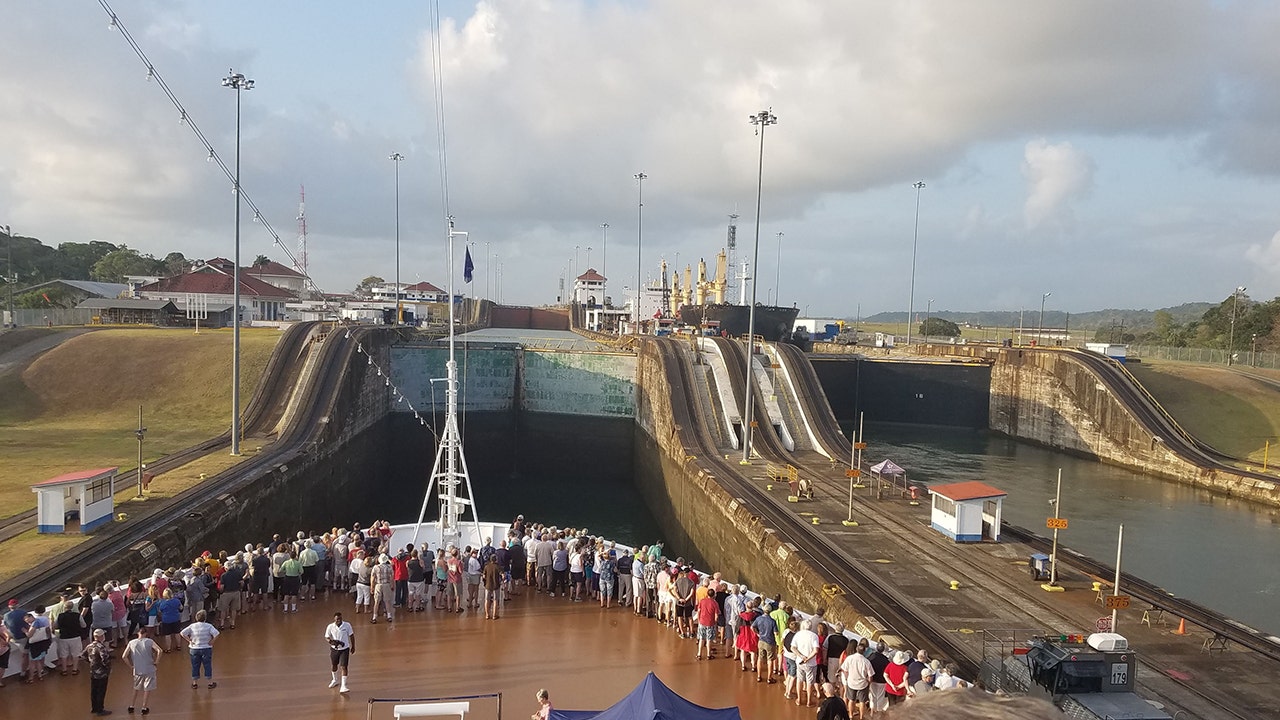Tomi Lahren: The war on Christmas continues
‘The Big Weekend Show’ panelists react to woke Christmas chaos including segregated Christmas parties, forcing Santa onto a nativity scene and a satanic display allowed in a state capitol.
At Christmastime, the last thing we wish for is to see Santa Claus idling away with no presents to deliver.
But if some holiday gifts should arrive late, neither Santa’s elves nor Rudolph the Red-Nosed Reindeer will be to blame.
Santa Claus idling away at Queens Center Mall in New York City. (Danuta Hamlin)
An unusually low water level at the Panama Canal could be the Grinch stalling ships carrying holiday cargo.

A cruise ship passing through the locks of the Panama Canal. (Danuta Hamlin)
The water is needed to raise and lower ships as they pass through the canal’s various locks, forcing officials to limit the number of vessels passing through. The ships either must wait at the canal’s point of entry or find another route altogether.

The gates of a lock in the Panama Canal opening. (Danuta Hamlin)
HOLIDAY GRIEF CAN BE HANDLED IN THESE 9 WAYS, ACCORDING TO MENTAL HEALTH EXPERTS
The Panama Canal is a waterway connecting the Pacific and Atlantic Oceans, but it does not use seawater. The locks on both ends are connected to Gatun Lake, an artificial reservoir. Fresh water flows into Gatun from the Chagres River and usually there is plenty of it. But the Central American nation known for its rainforests is suffering from drought, which in turn wreaks havoc on the shipping industry.

Picturesque Lake Gatun, Panama Canal. (Danuta Hamlin)
Built by the United States, the canal began operation over a century ago. We may take it for granted these days, but opening the path between the seas was an incredible achievement. It remains a true technological marvel, so much so that it’s honored as one of the Seven Wonders of the Modern World.

Panama Canal locks (Danuta Hamlin)
Before it was constructed, maritime crossings from one side of the Americas to the other was an iffy business. The ships had to sail all the way south and around Cape Horn, a rocky tip of Chile’s Tierra del Fuego archipelago, infamous for extremely treacherous waters and capricious weather conditions. The cape was first rounded in 1616 by Dutch navigator Willem Schouten, who named it after the Dutch city of Hoorn.

A tourist snaps an early morning photo of Cape Horn, Chile. (Danuta Hamlin)
As one might expect, this passage where the Atlantic and Pacific Oceans met and clashed into each other was dreaded by all, and seamen considered it a Godforsaken place. Through the centuries, countless ships were wrecked, and thousands of sailors are said to have lost their lives during the crossings.
PANAMA CANAL EXTENDS TRANSIT RESTRICTIONS, RAISING CONCERNS OVER CONSUMER GOODS PRICES
Even English naturalist Charles Darwin, founder of the theory of evolution, narrowly escaped that fate at Cape Horn around Christmas in 1832, sailing aboard the HMS Beagle.
Darwin described his ordeal: “Cape Horn, however, demanded his tribute… its dim outline surrounded by a storm of wind and water. Great black clouds were rolling across the heavens, and squalls of rain, with hail, swept by us with such extreme violence, that the captain determined to run into Wigwam Cove. This is a snug little harbor, not far from Cape Horn; and here, at Christmas-eve, we anchored in smooth water.”

Port Stanley, Falkland Islands (Danuta Hamlin)
Many vessels emerged from the Cape Horn passage badly damaged and were forced to retreat to Port Stanley in the nearby Falkland Islands for repairs.
With the dawn of the era of steam ships, which were able to cut through the rough waters with more ease than the traditional tall ships, the British suspended their ship repair operation.
These days, cruise ships make pit stops at Port Stanley for a very different reason. The Falkland Islands, an overseas territory of the British Crown, is home to a variety of penguins. The favorite of tourists is, of course, the king penguin. But the smaller penguins are just as adorable to watch.

King penguins tower over Gentoo penguins in the Falklands. (Danuta Hamlin)
CARGO SHIP BREAKS DOWN, HITS BRIDGE IN SUEZ CANAL
Cape Horn was a menace and a headache to the shipping companies. And by the mid-19th century, the British, and the French, as well as the Americans, began to toy with the idea of finding a way to cut through the thin sliver of Central America and make a swifter, safer and cheaper crossing from the Atlantic to the Pacific.
The French Panama Canal Company gave it a go first and embarked on the construction of a sea-level waterway, similar to the Suez Canal in Egypt. But they ran into an unexpected adversary… the mosquito, spreading malaria and yellow fever. In 1898, due to high mortality rates, engineering problems, and lack of investors, the company folded and went into bankruptcy. Many French citizens saw their entire investment wiped out and lost their life savings.

A cruise ship approaches the Panama Canal entry in Colón. (Danuta Hamlin)
However, this was not even remotely enough to scare away U.S. President Theodore Roosevelt.
“I took the Canal Zone,” he said, “and let Congress debate.”

Panamanian women selling tourist merchandise in Colón, Panama. (Danuta Hamlin)
With Roosevelt’s blessing, Panama separated from Colombia and in 1904 construction of the canal began in the U.S. controlled zone. This time, however, the plan was to create a lock-type waterway and an artificial freshwater lake fed by a local river and the ever-present rain. But before all this was even possible, a war was declared on mosquitoes to prevent the spread of yellow fever and malaria. On Aug. 15, 1914, the Panama Canal opened to traffic, and it forever changed maritime shipping patterns.

A vessel traveling across Gatun Lake, Panama. (Danuta Hamlin)
CLICK HERE TO GET THE FOX NEWS APP
But now, the recent scarcity of rain, so vital to canal operations, has created a bottleneck of vessels waiting to pass though the canal. Some companies are paying huge sums to move to the top of the wait-line, others are changing routes… putting the old adversary Cape Horn back on the shipping map.

View of the Panama City skyline, from the Pacific entrance of the canal. (Danuta Hamlin)
The problem is… being so far south, Cape Horn is quite a distance away from the North Pole. Santa Claus may well be in a bit of a pickle this holiday season.

Santa Claus at Queens Center Mall in New York City. (Danuta Hamlin)





